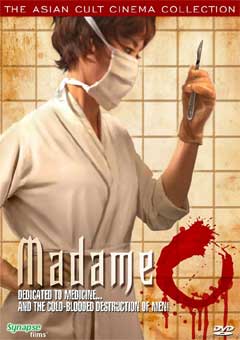 MADAME
O (1967)
MADAME
O (1967)Director: Seiichi Fukuda
Synapse Films
 MADAME
O (1967)
MADAME
O (1967)Synapse Films has graced many a collector's shelves with quality digital transfers of films with origins both stateside and abroad. Their Asian Cult Cinema Collection has in particular granted American shores with a number of entertaining eastern oddities, releasing films that both turn your stomach (ORGAN, ENTRAILS OF A BEAUTIFUL WOMAN) and reel your mind (WILD ZERO, PARTY 7). Well Synapse is at it again, this time resurrecting a cinematic gem of sex and deceit, long thought lost to the annals of time.
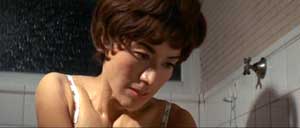
Seiko (Michiko Aoyama) is a well-respected doctor with a thriving practice. While her professional life prospers, the memory of a gang rape at the age of 16 has left Seiko’s personal life skewed, with a hatred for men that drives her out each night, looking for retribution. After hours, Seiko walks the streets and local taverns, seducing business men and bar patrons into one night stands of anonymous passion. Waiting for her prey to fall asleep, Seiko cuts her victims with surgical precision, before infecting the open wound with Syphilis, the same disease pasted on to her by one of her assaulters so many years ago. With her practice thriving, Seiko grudgingly hires a male doctor (Akihiko Kaminara) to assist her and her lone nurse (Naomi Tani). Seiko is initially cautious of her new colleague, but after he comes to her rescue after a failed self abortion, Seiko begins to let down her guard for the first time since she was a teen. Eventually the two doctors marry and Seiko's life finally seems to fall into place. However, the arrival of a past jilted lover throws Seiko into a panic that will inadvertently guide her to question her ideal life and seemingly perfect husband.
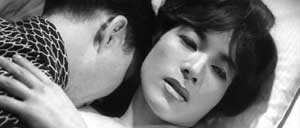 Short
and deadly, MADAME O is an incredibly enjoyable film. Running just over 80 minutes,
the plot is taught and deftly paced, unfolding naturally without a scene wasted.
While the film's lurid sexual nature and prerequisite rape revenge scenario
plant its feet firmly in the late 1960s “Pink Films”, its execution
feels more apropos to Film Noir. Switching back and forth, seemingly randomly,
from color to black and white, MADAME O surprisingly never feels disjointed,
however there are noticeable shifts in mood between the two stagings. As the
majority of the film is in black and white, it becomes the more comfortable
of the two, even when the actions portrayed are morally questionable at best.
Often accompanied by a jazzy score, Seiko's voiceover narration, a common plot
device for Film Noir, charts her motivations as a bitter femme fatale, who prefers
to infect her victims with lifelong discomfort and shame, as opposed to outright
killing them. In black and white these scenes often have a heavy feel to them,
an oppression that lingers even during scenes of passion. She is a woman with
a singular goal in mind and could care less about any form of pleasure that
the act of sex might bring other than the satisfying aftermath of sexual payback.
Short
and deadly, MADAME O is an incredibly enjoyable film. Running just over 80 minutes,
the plot is taught and deftly paced, unfolding naturally without a scene wasted.
While the film's lurid sexual nature and prerequisite rape revenge scenario
plant its feet firmly in the late 1960s “Pink Films”, its execution
feels more apropos to Film Noir. Switching back and forth, seemingly randomly,
from color to black and white, MADAME O surprisingly never feels disjointed,
however there are noticeable shifts in mood between the two stagings. As the
majority of the film is in black and white, it becomes the more comfortable
of the two, even when the actions portrayed are morally questionable at best.
Often accompanied by a jazzy score, Seiko's voiceover narration, a common plot
device for Film Noir, charts her motivations as a bitter femme fatale, who prefers
to infect her victims with lifelong discomfort and shame, as opposed to outright
killing them. In black and white these scenes often have a heavy feel to them,
an oppression that lingers even during scenes of passion. She is a woman with
a singular goal in mind and could care less about any form of pleasure that
the act of sex might bring other than the satisfying aftermath of sexual payback.
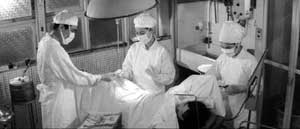
In contrast, those scenes presented in color feel akin to the American exploitation pictures of the same period. Such a grindhouse temperament is most assuredly in part to the specific actions chosen to have been displayed in color, including the film's opening surgery, which incorporates actual surgical footage (and quite flawlessly I might add) and Seiko’s flashback to the day she was raped. Director Seiichi Fukuda's decision to switch back and forth from black and white to color is also brilliantly used to better illustrate Seiko’s changing demeanor and motivations. Of the film's numerous sex scenes, which are considerably tame for the era, those in black and white feel rough and unemotional. In such black and white scenes, Michiko Aoyama, who is superb throughout the film, appears almost mannish, negating any femininity or passion in place of unbridled hatred and disgust for the opposite sex. However, during similar scenes in color, she comes across sensual and profoundly feminine. It is only after initial viewing that you come to realize that the act of switching to and from color may not have been as random as it first seemed.
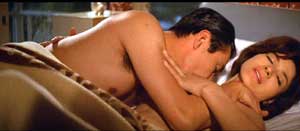 Synapse
Films presents the original U.S. theatrical version of MADAME O, originally
released in theaters stateside through Radley Metzger’s Audubon Films,
in its original 2.35:1 aspect ratio with anamorphic enhancement. There is a
scratched vertical line that dances about the middle of the frame for the film's
opening minutes; it is however slight and quickly dissipates, leaving nothing
to distract from an otherwise crisp transfer. Blacks are rich and greys are
sleek throughout the film's black and white segments, as are the films random
color sections equally bold. Fleshtones appear accurate; with details so sharp
you can see the post-coital sweat glistening from Seiko’s brow. It is
exactly the type of superlative transfer that fans have come to expect from
Synapse. The Dolby Digital 2.0 English dubbed audio is clear and easy to follow,
never overwhelming the film's moody score. Special Features include the film's
original Americanized trailer and liner notes from MidnightEye.com co-editor,
Japser Sharp, laying out a brief history of the eroduction (Pink Film) boom,
taking special note to highlight what a rare treasure Synapse has so thankfully
chosen to liberate. (Jason
McElreath)
Synapse
Films presents the original U.S. theatrical version of MADAME O, originally
released in theaters stateside through Radley Metzger’s Audubon Films,
in its original 2.35:1 aspect ratio with anamorphic enhancement. There is a
scratched vertical line that dances about the middle of the frame for the film's
opening minutes; it is however slight and quickly dissipates, leaving nothing
to distract from an otherwise crisp transfer. Blacks are rich and greys are
sleek throughout the film's black and white segments, as are the films random
color sections equally bold. Fleshtones appear accurate; with details so sharp
you can see the post-coital sweat glistening from Seiko’s brow. It is
exactly the type of superlative transfer that fans have come to expect from
Synapse. The Dolby Digital 2.0 English dubbed audio is clear and easy to follow,
never overwhelming the film's moody score. Special Features include the film's
original Americanized trailer and liner notes from MidnightEye.com co-editor,
Japser Sharp, laying out a brief history of the eroduction (Pink Film) boom,
taking special note to highlight what a rare treasure Synapse has so thankfully
chosen to liberate. (Jason
McElreath)